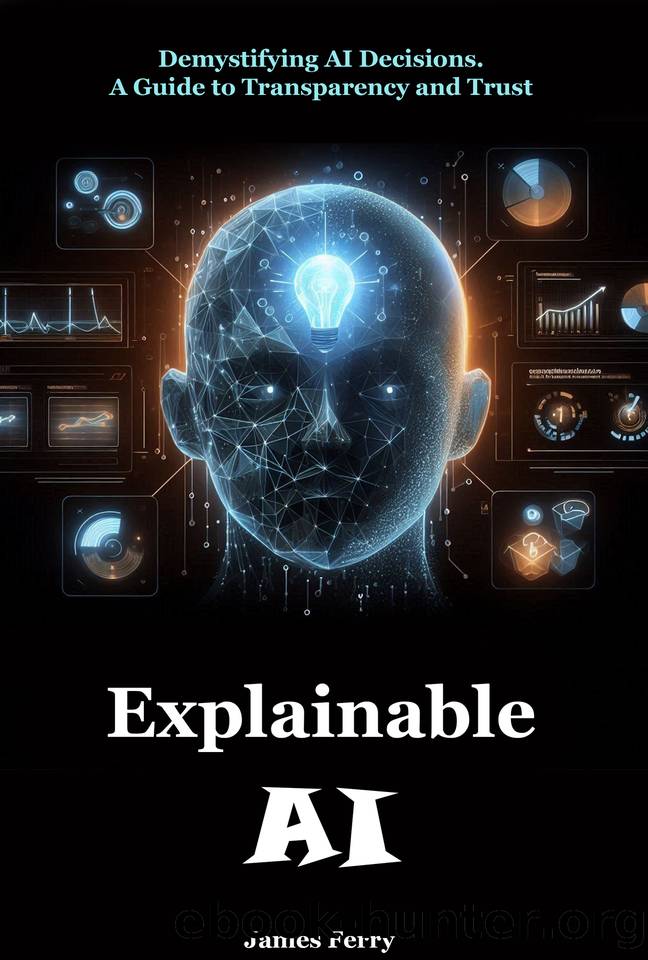Explainable AI: Demystifying AI Decisions. A Guide to Transparency and Trust by Ferry James

Author:Ferry, James
Language: eng
Format: epub
Published: 2024-06-19T00:00:00+00:00
Chapter 5: Real-World Applications
Healthcare: How XAI is revolutionizing diagnostics and treatment decisions.
Explainable AI (XAI) is making significant strides in revolutionizing diagnostics and treatment decisions within the healthcare industry, offering transparency and insights that enhance clinical decision-making processes. In healthcare, where accuracy, reliability, and accountability are paramount, XAI techniques play a crucial role in improving patient outcomes, reducing errors, and optimizing resource allocation. Hereâs how XAI is being applied in real-world healthcare scenarios:
Enhanced Diagnostic Accuracy: XAI tools such as LIME and SHAP are employed to provide explanations for diagnostic decisions made by AI systems. These tools help healthcare professionals understand which features or symptoms contributed most significantly to a particular diagnosis. For instance, in medical imaging diagnostics, XAI can highlight regions in an image that influenced the AI's decision, aiding radiologists in confirming or revising diagnoses based on visual evidence.
Personalized Treatment Planning: XAI enables personalized treatment planning by identifying the factors that contribute to treatment recommendations. By explaining the rationale behind treatment decisions, XAI helps healthcare providers tailor therapies to individual patient characteristics, preferences, and medical histories. This approach ensures that treatments are not only effective but also aligned with patient needs, enhancing overall patient satisfaction and outcomes.
Improving Clinical Decision Support Systems: XAI integrates seamlessly with clinical decision support systems (CDSS), providing healthcare professionals with transparent insights into AI-generated recommendations. By offering explanations for treatment options or medication choices, XAI helps clinicians make informed decisions based on evidence-backed insights. This capability is particularly valuable in complex cases where multiple treatment options exist, allowing physicians to weigh the pros and cons of each option with confidence.
Detection of Medical Errors and Bias: In healthcare, mitigating errors and biases in AI systems is crucial for patient safety and trust. XAI tools facilitate the detection of potential biases or errors by revealing how AI models interpret and weigh different patient characteristics or data inputs. By identifying discrepancies or inconsistencies, healthcare providers can refine AI algorithms, improve model performance, and ensure equitable treatment for all patients.
Regulatory Compliance and Ethical Considerations: XAI supports healthcare organizations in meeting regulatory requirements and ethical guidelines related to AI deployment. By providing transparent explanations of AI decisions, healthcare providers can demonstrate compliance with data privacy regulations (e.g., GDPR) and ethical principles governing patient care. This transparency fosters trust among patients, caregivers, and regulatory bodies, paving the way for responsible AI adoption in healthcare.
Research and Development Advancements: Beyond clinical applications, XAI is instrumental in advancing medical research and development. By elucidating complex relationships within biomedical data, XAI accelerates discoveries, identifies novel biomarkers, and enhances predictive models for disease prevention and early intervention. This capability is pivotal in driving innovation and improving healthcare outcomes on a broader scale.
Download
This site does not store any files on its server. We only index and link to content provided by other sites. Please contact the content providers to delete copyright contents if any and email us, we'll remove relevant links or contents immediately.
Deep Learning with Python by François Chollet(14616)
The Mikado Method by Ola Ellnestam Daniel Brolund(11877)
Hello! Python by Anthony Briggs(11791)
OCA Java SE 8 Programmer I Certification Guide by Mala Gupta(11240)
Dependency Injection in .NET by Mark Seemann(11001)
A Developer's Guide to Building Resilient Cloud Applications with Azure by Hamida Rebai Trabelsi(10517)
Algorithms of the Intelligent Web by Haralambos Marmanis;Dmitry Babenko(9832)
The Well-Grounded Java Developer by Benjamin J. Evans Martijn Verburg(9420)
Grails in Action by Glen Smith Peter Ledbrook(9163)
Hit Refresh by Satya Nadella(9038)
Sass and Compass in Action by Wynn Netherland Nathan Weizenbaum Chris Eppstein Brandon Mathis(8808)
Secrets of the JavaScript Ninja by John Resig Bear Bibeault(8594)
The Kubernetes Operator Framework Book by Michael Dame(8467)
Test-Driven iOS Development with Swift 4 by Dominik Hauser(8309)
Exploring Deepfakes by Bryan Lyon and Matt Tora(8287)
Robo-Advisor with Python by Aki Ranin(8241)
Practical Computer Architecture with Python and ARM by Alan Clements(8217)
Implementing Enterprise Observability for Success by Manisha Agrawal and Karun Krishnannair(8187)
Building Low Latency Applications with C++ by Sourav Ghosh(8089)
